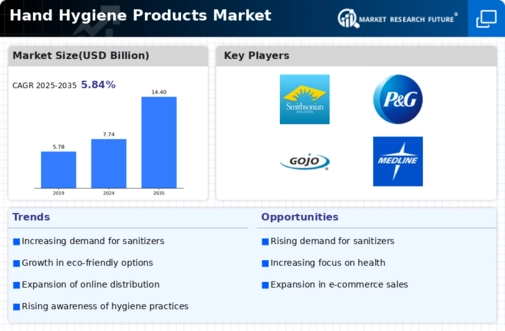Market Analysis
In-depth Analysis of Hand Hygiene Products Market Industry Landscape
The market factors influencing the hand hygiene products market encompass a wide range of elements, from consumer behavior to technological advancements and regulatory standards. Firstly, heightened awareness of infectious diseases, including the COVID-19 pandemic, has significantly increased the demand for hand hygiene products. Individuals and organizations alike are prioritizing hand hygiene as a fundamental measure to prevent the spread of germs and pathogens, driving market growth.
Moreover, evolving consumer preferences and lifestyles play a crucial role in shaping market dynamics. Busy schedules, increased urbanization, and a growing emphasis on health and wellness have led to a greater demand for convenient and portable hand hygiene solutions. Products such as hand sanitizers, hand wipes, and antibacterial soaps cater to the needs of consumers seeking quick and effective ways to maintain cleanliness on-the-go, driving market expansion.
Additionally, technological advancements in product formulations and manufacturing processes have revolutionized the hand hygiene products market. Companies are investing in research and development to enhance the efficacy, safety, and sustainability of their products. Innovations such as long-lasting antimicrobial agents, eco-friendly packaging, and touchless dispensing systems contribute to market competitiveness and consumer satisfaction.
Economic factors, including disposable income levels, purchasing power, and consumer spending habits, also influence the hand hygiene products market. Economic stability and prosperity generally correlate with increased consumer spending on health and hygiene products. Conversely, economic downturns may lead to shifts in consumer behavior, with some individuals opting for lower-priced alternatives or reducing overall spending on non-essential items.
Furthermore, regulatory standards and guidelines governing product safety, efficacy, and labeling play a significant role in shaping market dynamics. Compliance with regulatory requirements is essential for manufacturers to ensure product quality and consumer trust. Changes in regulations, such as bans on certain chemicals or ingredients, can impact product formulations and manufacturing processes, influencing market offerings and consumer choices.
The competitive landscape and market dynamics are also influenced by factors such as brand reputation, marketing strategies, and distribution channels. Established brands often leverage their reputation and consumer trust to maintain market share and drive product sales. Effective marketing campaigns, including advertising, promotions, and endorsements, play a crucial role in shaping consumer perceptions and influencing purchasing decisions.
Moreover, cultural and societal factors, including cultural norms, lifestyle trends, and demographic shifts, influence market preferences and consumption patterns. For example, growing concerns about environmental sustainability may drive demand for eco-friendly hand hygiene products made from biodegradable materials or natural ingredients.
In conclusion, the hand hygiene products market is influenced by a complex interplay of market factors, including consumer awareness, technological innovations, economic conditions, regulatory standards, competitive dynamics, and cultural influences. As hand hygiene continues to remain a critical aspect of public health and wellness, the demand for effective and convenient hand hygiene products is expected to persist, driving further innovation and market growth in the foreseeable future.








Leave a Comment